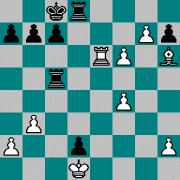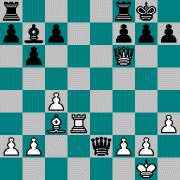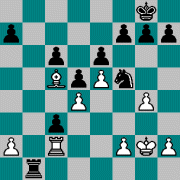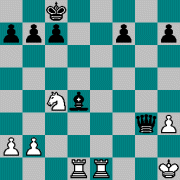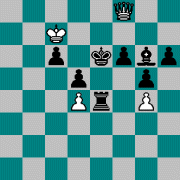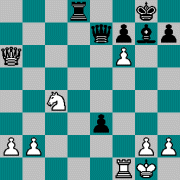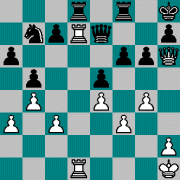Last updated 20 November 1999.
Anyone can hang a piece, but a good blunder requires thought. There
is one sort of move that is almost always played after calm, if not happy
contemplation: resigning. Sometimes it is wrong to resign - or to agree
to a draw. Recently in Dos Hermanas, Svidler took a draw against Anand
when he had a forced win. Kasparov made both blunders within a few months
in 1997, first resigning a game against Deep Blue that he could have drawn,
then taking a draw against Lautier in a position that he could have won.
But those are blunders that only cost half a point
- the ultimate blunder is when a player resigns in a winning position.
It happens more often than you might think; in my ramblings through chess
literature I have come across 35 examples. Click here
to go to the first, and then click the diagrams to go to the next one.
|
1 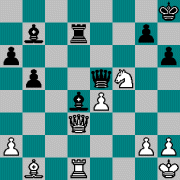
|
Black to play
Von Popiel - Marco Monte Carlo 1902 This is the earliest, the most famous, and still the clearest example of this blunder. Black resigned because he saw he was going to lose the Bd4. He could have won on the spot with 36...Bg1 |
|
2 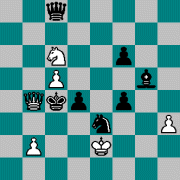
Black to play
|
Krejcik - Schwarz
Vienna 1905, city championship Seeing the fork 1...Kd5 2.Ne7+ Black resigned, but after 2...Ke4 3.Nxc8 f3+ 4.Kf2 (otherwise a counterfork) Bh4+ 5.Kg1 f2+ 6.Kh2 f1Q he would have won; his king will escape the checks and he will mate White soon. |
|
|
Torre - Parker
The Mexican grandmaster did not see what he could do against Rc1+ and
promotion, and resigned. With 1.Rd6! he could have saved the day, and even
have won: e.g. 1...Rxd6 2.g8Q+ Kd7 (Rd8 3.Qxd8+ and 4.f7) 3.Qf7+ Kc6 4.Qe8+
Kb6 5.Qe3 Kc6 6.Qxc5+
|
|
|
Ahues - NN
Berlin 1920 In this 'free' game, White had just sacrificed his Queen on f6 and Black resigned - what can he do against mate? 1...Qe1+ 2.Kh2 Qxc3 3.Qxc3 isn't much fun. But with 1...Qg4 (sadistically, he could first play Qd1+), he could have remained a Rook to the good. |
|
|
Meyrinck - Eilinger
1936 Black played the nice combination 1...Ne3+ 2.fxe3 Rb2 and White resigned because the promotion cannot be stopped. That was true, but he missed an equally nice countertrick: 3.Rf2 c2 4.Ba3 c1Q 5.Rxb2 and the back rank threat costs Black his new queen. PS 28 April 2005: As Kirill Kryukov shows, 4...c1Q is not forced. With 4...Rxa2! Black can still draw, e.g. 5.Bc1 a5 6.Kf3 a4 7.Rd2 h5 8.Ke2 a3 9.Kd3 Ra1 10.Rxc2 a2 11.Bd2 hxg4 12.Kc3 Rh1 13.Rxa2 Rxh2 etc. So this is really only a resignation in a drawn position. |
|
6 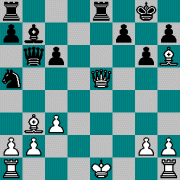
White to play
|
NN - Sonnenschein
Berlin 1937 White resigned because he was losing his Queen, but he could have mated
in a few moves: 1.Bxf7+ Kxf7 2.Rf1+ Kg8 3.Rf8+ Rxf8 4.Qg7 mate
|
|
7 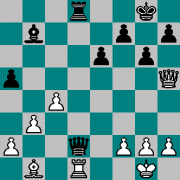
White to play
|
NN - Grammatikoff
London 1938 Here, White resigned in view of 1.Rxd2 Rxd2 2.Qg4 h5 when he would end
up a Rook down. He overlooked 2.Bxg6 hxg6 3.Qg4, when there will be no
h5.
|
|
8 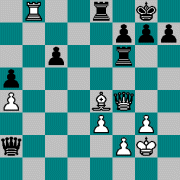
Black to play
|
Goldstein - Turi
In this strange case, Black is the exchange and a pawn up, and after 1...Qe6, he must eventually win. However, he saw something even better: 1...Qxf2+ - and resigned immediately after playing it. One wonders what he could have thought, both in playing that move and in resigning. The move was very good: either he takes the white Queen with check and after that the Rb8, or there follows 2.Kh3 Rh6+ 3.Qxh6 gxh6 4.Rxe8+ Kg7 and Black wins. Did he overlook the flight square on g7 in that last variation? |
|
9 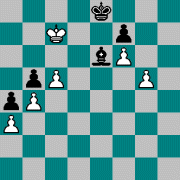
White to play
|
Keller - Schlemmer
This was the final position of a decisive last round game; by winning
it White would have tied for the championship. According to the story,
Keller said: 'It's over.'
|
|
|
Kofman - Sacchetti
Bucarest 1948 White, a renowned problem composer who later emigrated to the Soviet Union, resigned here because he did not see what he could do against Qxh3 mate. He could have won a piece and the game by 1.Re8+ Kd7 2.Re3 Qg7 (or Qf4 or Qh4) 3.Rxd4+ (Qxd4 4.Rd3 Qxd3 5.Ne5+) |
|
11 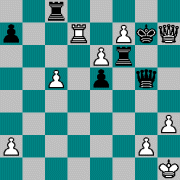
Black to play
|
Romi - Staldi
Italy, Championship 1954 Black was so shocked by the Queen sacrifice on h7 that he resigned immediately. But after 1...Kxh7 2.f8Q+ Kg6 3.Rg7+ (3.Qxc8 Rf1+ and mate) there follows Kh6 (a difficult move to see ahead, but he could have let the situation arise) and Black remains a rook up. |
|
12 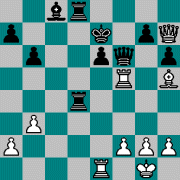
Black to play
|
Wolk - Oswald
1954 White had just played Re5-f5 and Black resigned because of 1...Qh4 2.g3
Qh3 3.Qxg7+ and Qxd4+ However, 1...Re4 would have turned the tables: because
2.Rxe4 Qa1+ (note the double clearance of the diagonal) is mate, the mating
threat Rxe1 means Black can simply take the Rf5 next move, and will remain
a rook up.
|
|
13 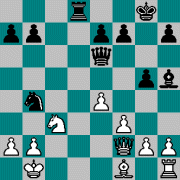
Black to play
|
Negyesi - Honfi
Budapest 1955 A case of mutual blindness, based on the overburdening of the Nc3. It
has to guard against Rd1+ and Qxa2+. But 19...Rd1+ 20.Nxd1 Qxa2+ 21.Kc1
and Black has nothing. Therefore: 19...Qxa2+ The other way round!
White resigned in view of 20.Nxa2 Rd1 mate. Both overlooked the fact that
the deflected knight has a new defense: 21.Nc1
|
|
14 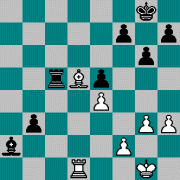
Black to play
|
Rudenko - Rootare
USSR 1956 In her winning position (but not 29...Rxd5 30.exd5 b2 31.d6), Black saw an immediate decision, and played 29...b2 White, the women's World Champion 1950-1953, resigned because of 30.Bxa2 Rc1 and queens. Only later did both notice that after 31.Rf1, there is no queening, and Black would have had to resign. PS 1 February 2012: Geir Řstmoe comments that Black did not have to resign, and was very likely not lost at all. Dealing with the Pb2 is such a cumbersome affair that White cannot at the same time defend her last pawn.
|
|
|
Sanguineti - Najdorf
|
|
16 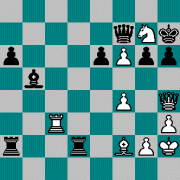
White to play
|
Mathot - Baumgartner
White resigned in view of the Rooks' power on the second rank. 1.Rc8
however, would have been a forced win. The threat is 2.Qxh6+ and Rh8 mate,
and 1...h5 doesn't help because of 2.Qg5 and the threat is renewed. Or
1...g5 2.fxg5 Qg6 3.Nxe6 and there is nothing against 4.Nf8+, winning the
Queen. An interesting try is 1...Qg8!? because after 2.Rxg8 Kxg8 the black
Rooks would still be killing. But after 2.Nf5 or even better 2.Nxe6 (Qxc8
3.Ng5+ Kg8 4.Qxh6) Black is still lost.
|
|
17 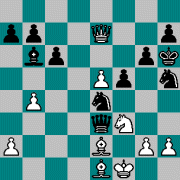
Black to play
|
Ortega - Etcheverry
Black, who had been better all along, decided the game here with the
nice double decoy 38...Nd2+ White resigned, because on 39.Nxd2,
there follows Qg1 mate, and on 39.Bxd2, there follows Qf2 mate.
|
|
18 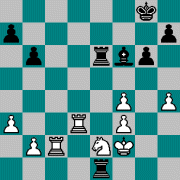
Black to play
|
Darga - Lengyel
Amsterdam izt 1964 Black played 41...R6xe2+, and White resigned. Both players overlooked
that after 42.Rxe2 Bxh4+, 43.Kg2 is not forced; 43.Ke3 is possible. Perhaps
it was logical to miss that, e3 being so very inaccessible to the white
King before (Ke3-f2 had been White's last move.)
|
|
19 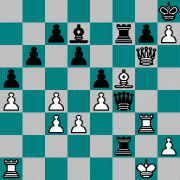
Black to play
|
Langeweg - Krabbé
Zierikzee 1967, championship Netherlands Seeing nothing against Qxf7, Black resigned. Later, Kurt Richter showed
in the Deutsche Schachzeitung that he could have drawn with 32...Rc2 33.Rf1
Rc1 etc. But over 30 years later, in his book 'Der letzte Fehler', Klaus
Trautmann showed Black could even have even won: 32...Rc2 33.Rf1 and now
Qd2! and 34.Rg2 Qxg2+ 35.Qxg2 Rxg2+ 36.Kxg2 Bxa4 and wins, or 34.Rh3 Bxa4
35.Kh1 Be8 36.Rg1 Re7 37.Qf6 Qg2+ 38.Rxg2 Rc1+ 39.Rg1 Rxg1+ 40.Kxg1 gxf6
'White will hardly find a way out'.
|
|
20 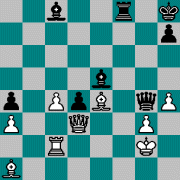
White to play
|
W. Schmidt - Kwasniewski
Lublin 1969, ch Poland White played 41.Bxd4, whereupon Black, instead of remembering
that important maxim 'patzer sees an adjournment, patzer gives an adjournment,'
resigned. With 41...Qh3+ 42.Kg1 Rf1+ 43.Qxf1 Bxd4+ 44.Rf2 Qxg3+ 45.Bg2
Bb7 46.Kh1 Qxh4+ 47.Kg1 Qg3 48.Kh1 Bxg2+ 49.Qxg2 Qxf2 he had an entirely
forced win.
|
|
21 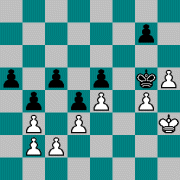
Black to play
|
Havasi - Reko
Budapest 1976 Black resigned, missing a deep, but entirely forced win with a well-known breakthrough: 1...c4 2.bxc4 (2.dxc4 a4, and now either 3.bxa4 b3 or 3.c5 axb3 as in the main line. Or 2.Kg3 c3 3.bxc3 a4 4.bxa4 dxc3 etc.) a4 3.c5 a3 4.bxa3 bxa3 5.c6 a2 6.c7 a1Q 7.c8Q Qf1+ 8.Kg3 Qf4+ 9.Kh3 Qf3+ 10.Kh2 Qf2+ 11.Kh3 Qh4+ 12.Kg2 Qxg4+ 13.Qxg4+ Kxg4 and wins. |
|
22 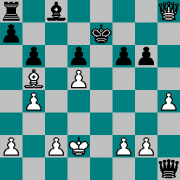
Black to play
|
Zinn - Syre
Dresden 1977 Mutual blindness again. Black, a Rook up but faced with a nasty mating threat, could have won immediately with 1...Qd1+ when White cannot stay off the white squares for long, allowing Black a winning check with his Bc8. But play continued: 1...Kf7? 2.Be8+ (the repetition with Qh7+ and Qh8+ was easier) Ke7 and here White still had a draw with 3.Bxg6 Qd1+ 4.Kc3 Qe1+ etc. After 3.Bc6?, Black resigned. He still had that win with Qd1+ |
|
23 
White to play
|
Kotov - Lambert
The game was adjourned in the position of the diagram. Lambert offered a draw, which was stupid enough, but when Kotov told him his sealed move was 42.Re6+ and the intended continuation 42...Kd7 43.Rxe8 Kxe8 44.Re6+ followed by Rxe4 and Rxg4, he even resigned. Kotov's great authority may have helped him to miss that with 43...g3, instead of recapturing the Rook, he could have won - the adjourned position was a forced win for him. |
|
24 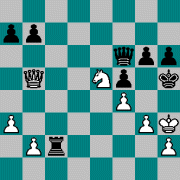
Black to play
|
Dekhanov - K. Yusupov
Uzbekistan Championship 1981 Black (not grandmaster Arthur) played 1...Qa6 and White resigned, thinking the possibility of Qf1 mate forced an exchange of Queens. He missed a very nice forced mate: 2.g4+ fxg4+ 3.Nxg4+ g5 (Qxb5 4.Nf6 mate) 4.Qe8+ Qg6 5.Nf6 mate |
|
25 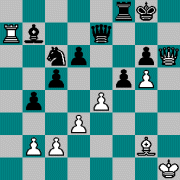
White to play
|
Veprek - Glaz
Bad Kissingen 1982 After 33.Rxb7, Black resigned. She saw no defense; 33...Qxb7
34.exf5 and Bd5+ will decide. Her main reason was that after 34...Qh7 35.Bd5+
Kh8 36.Qxf8+ would be mate - missing that the Queen would have been pinned.
|
|
26 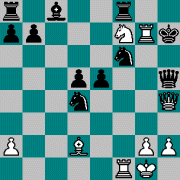
Black to play |
Rijnsbergen - v.d.Weijden
Haarlem 1983 From a club match in Holland. White had just sacrificed his rook on
g7, and Black resigned because of 1...Kxg7 2.Qxf6+ Kg8 3.Nh6+ when he must
give the Queen. That wouldn't have mattered however: 3...Qxh6 4.Qxh6 Ne2+
5.Kh1 Rxf1 mate. For the same reason, Black could play 2...Kh7; 3.Ng5+
Qxg5! etc.
|
|
|
Jonasson - Angantysson
Iceland 1984 What Black invented here went around the world as a brilliancy: 26...e2 (Bxf6 would have won easily) 27.fxe7 Bd4+ and White resigned. Very nice. Months later, a reader of the Observer chess column, which was one of the many where this combination was published, asked what happens if White plays 28.Ne3. |
|
28 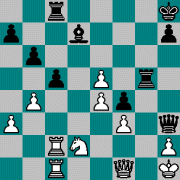
Black to play
|
Samarin - Antoshin
Berdyansk 1985 This too was published as a nice combination by Black - in the Latvian SAHS this time. With 35...Qxh2+ 36.Kxh2 Rcg8, he threatened an unstoppable mate. White agreed, and resigned. With two clever moves however, as reader E. Veveris from Riga demonstrated, 37.e6 and 38.Rxc5, he could have remained a rook ahead. |
|
|
Martorelli - Antunes
Reggio Emilia II 1985/86 Black, seeing no defense to White's threats, resigned. For instance:
39...Rxd7 40.Rxd7 and wins. Or 39...Rf7 40.Rxe7 Rxd1+ 41.Kg2 Rxe7 42.Qf8
mate. But with 39...Qf7! Black could have stopped White's attack. After
40.R1d5 (only move) Qg8 42.Rxc7 Rf7 Black should win.
|
|
30 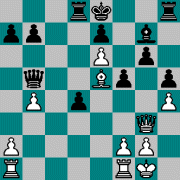
Black to play
|
Sznapik - Van Gils
Liege 1986 Blindness of a special kind; forgetting the rules. Black didn't see how he could avoid losing a Bishop without being mated by Qxg6+, and resigned. The Polish master then pointed out 20...O-O to him ('and Black is better'), a possibility that had not occurred to Van Gils. 'Black is better' was a euphemism, to use a euphemism. After 21.Bxg7 Kxg7 Black, with his royal extra pawn and White's weaknesses on b4 and e6, is winning. Van Gils suggested to me that White's title's authority might have contributed to his blunder. |
|
31 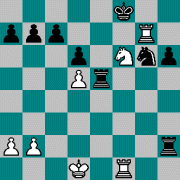
White to play
|
Matamoros - Klinger
Gausdal Junior World Championship 1986 A special case. In great time trouble White touched his Knight, saw he could have won by simply Rxg6, panicked about losing his Rg7 now, and resigned. With 36.Nh5+ however, he could have reached the same position and still have taken the Knight: 36...Ke8 37.Nf6+ Kf8 or Kd8 and now 38.Rxg6 winning a piece and with a winning attack. |
|
32 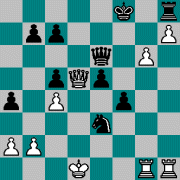
White to play
|
Both - Späte
Women's Championship Germany, Bad Lauterberg 1987 A parallel to Keller - Schlemmer (diagram 7). This too, was a decisive last round of a German Women's Championship and here too, White resigned in a won position. In view of g7+, 40.Kc1 would have been enough. Had White won she, and not Späte, would have been champion. |
|
33 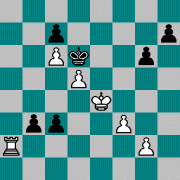
White to play
|
Hartmann - Rädisch
Correspondence, 1987 In this position, again from a correspondence game, White resigned as the passed pawns cannot be stopped. He didn't see that they do not need to be stopped: 1.Re2! c2 2.Kd4 and Re6 mate. Even 1.Ra1 wins (b2 2.Re1 Kc5 3.Kd3) |
|
34 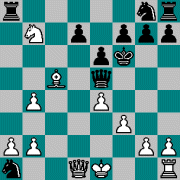
White to play
|
Nagler - Wolkenstein
Eberswalde 1995 Total blindness. After 1.Bd4? (Qxa1!) Black resigned, missing the not too difficult 1...Nc2+ and Black remains a rook up. |
|
35 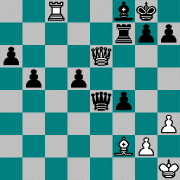
White to play
|
Glek - Lazarev
Porto San Giorgio 1997 Black had been pestered with a threat on f8 for a long time, and believed to have finally succumbed to it when White played 43.Rxf8+ He resigned, but after Kxf8 44.Bc5+ Re7 45.Bxe7+ Ke8, 46.Qxe4 would be forced, and Black shouldn't have too much trouble winning, e.g. 46...dxe4 47.Bg5 a5 48.Bxf4 Kd7 49.Be5 g6 50.Kg1 Ke6 51.Bg7 Kd5 52.Kf2 Kc4 53.Ke3 b4 54.Kxe4 a4 55.Ke3 Kb3 56.Kd2 Ka2 and a pawn promotes. |
I'm a bit surprised that there are only two example from after 1987. Isn't this blunder en vogue anymore? Did I forget to collect? Any help?
© Tim Krabbé 1999 - 2014
With thanks to René Olthof, Joop Simmelink, Martin
van Gils, Eduardo Bauzá Mercére, Michal Rudolf, Kirill Kryukov, Geir Řstmoe.
Comments and suggestions
Top of this page | Main
chess page | Main
page
